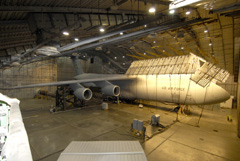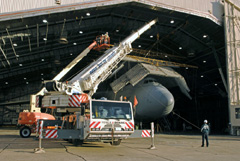
|
C-5M Undergoes Testing at
World's Largest Climatic Laboratory
|
||
|
11/21/2007 - EGLIN AIR FORCE BASE, FL -- Blazing desert heat. Sub-zero arctic chill. The Air Force's largest transport aircraft. All this tucked into the world's largest environmental testing chamber where tests can be conducted without a mile being flown during a unique series of tests conducted at the McKinley Climactic Laboratory from Oct. 21 through Nov. 17 here. The C-5M Super Galaxy will undergo testing to determine the durability and functionality of subsystems and engines new to the airframe. An aggressive program to modernize the C-5. The C-5 Avionics Modernization Program began in 1998 and includes upgrading avionics to Communications, Navigation, Surveillance/Air Traffic Management compliance, improving navigation, communication, and safety equipment, and installing a new autopilot system. Another part of the modernization plan is a comprehensive Re-engining and Reliability Program, which includes new CF-6 engines, pylons and auxiliary power units, with upgrades to the aircraft's skin and frame, flight controls, landing gear and pressurization system. This modernization program will enhance aircraft reliability and maintainability, maintain structural and system integrity, reduce cost of ownership and increase operational capability well into the 21st century, according to an AF Link article published Nov. 26, 2006. Once the data is collected, it will be sent to Lockheed Martin engineers for review and to possibly improve to this upgrade on a 35-year-old airframe. The main challenge the engineers and crew faced while setting up the C-5M in the hangar was getting it inside, since the C-5's tail is taller than the door opening and some of the structural piping in the hangar. "We looked at the (specifications) of the hangar and compared them to the (specifications) of the C-5 so we knew it would fit but we just didn't have anyone with experience from the test in 1969," said King Molder, McKinley Climatic Laboratory test engineer. "It was a little like trying to figure out how to put the pirate ship in the bottle." The significance of completely moving a C-5 inside the hangar is noteworthy. "This is the only place on Earth where a C-5 can be in a controlled climate," said Kirk Velasco, McKinley Climatic Laboratory Flight Chief. "There is no other facility around that can house this airframe in a fully enclosed building for climatic testing." The tests are a landmark for the climatic lab as it
is the first time since 1969 a C-5 has been contained
completely inside the hangar and the first time in the
history of the laboratory that a C-5's engines were
run while in the hangar. "Here, guaranteed, our customers are always going to get exactly what they need," said Mr. Velasco. "If they order extreme heat in the dead of winter, they will get it." Conceived during World War II and completed in 1947, the site provides facilities for all-weather testing of weapons and ancillary equipment to ensure their function regardless of climatic conditions. The hangar has the capability to drop in temperature rapidly or mimic Mother Nature with a gradual lowering (as low as minus 70 degrees Fahrenheit) or rising (as high as 180 degrees Fahrenheit) of temperatures. The C-5M is currently in the largest of six operational chambers available to both the military and commercial enterprises. For the testing on the C-5's avionics and engines, Lockheed Martin requested temperatures remain at a steady state to determine how the new technology held up in the extreme spectrums of the temperature chart. This new initiative has paired the military up with Lockheed Martin to help generate the changes necessary to keep the C-5 a functional and successful member of the Air Force fleet. Lockheed Martin requires the C-5M to have tests conducted on the new engine modifications and avionics fitted for the aircraft upgrade. These tests require testing in conditions of extreme cold reaching minus 40 degrees Fahrenheit and in extreme heat reaching over 150 degrees Fahrenheit. The extreme heat is generated by more than 90 solar panels mounted over the aircraft to accurately display solar radiation. "The reason these specific temperatures were requested is because most aircraft have technical problems occurring when they are in environments which favor the extreme temperatures," said Mr. Molder. "We're always cautious with the extreme cold and conducting engine testing as fuel controls tend to freeze and there's the added risk of damage to the aircraft." The tests come two years after the initial baseline testing was conducted in the hangar on the upgraded avionics system. Lockheed Martin will use these results to compare against the latest findings to further refine and improve the airplane. "Currently, there are only three C-5Ms in production and testing similar to what is being conducted at (McKinley Climatic Laboratory) are necessary to continue making upgrades to more of the airplanes," said Dwayne Bell, McKinley Climatic Laboratory test engineer. Source: USAF Press Release by Staff Sgt. Stacia Zachary |
|
|
All original content Copyright © 2006 - 2008 The North Spin

